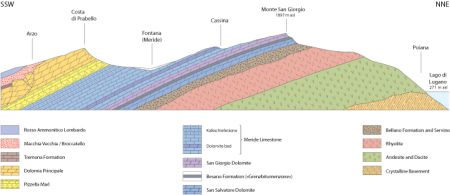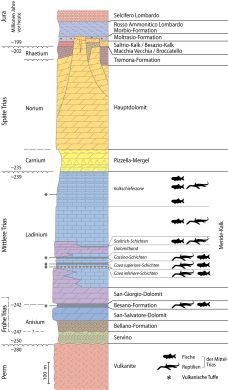Geological setting
The topography of Monte San Giorgio was created at the same time as the surrounding Alps, when, 95 millions years ago, the “African” plate began to move northwards, progressively compressing the “Eurasian” plate. The powerful push of the African plate caused a series of deformations within a collisional zone, including the area of Monte San Giorgio in its southern part. The ancient seabed was pushed upwards, emerging from the water and building the mountain we know today.
Now, Monte San Giorgio is a pyramid-like mountain of about 1,100 metres in height, formed by overlapping rocks of various types dipping approximately 30° southward. These rocks were formed under a range of different environmental conditions and during several geological periods. The most ancient rocks are composed of gneiss (the so called ‘crystalline basement’) dated to before the Carboniferous period. They are however practically invisible, as they are situated almost entirely below the level of Lake Lugano. Lying on top of these are thick volcanic rocks of the Permian period (andesites, rhyolites), which are succeeded by the equally impressive series of Triassic and Jurassic sedimentary rocks now known to be fossil-rich (limestones, dolomites, marls, bituminous shales, etc.).
North-South section of Monte San Giorgio, illustration H. Furrer, 2014

Monte San Giorgio is geologically part of the wider “Southern Alps”, which includes sedimentary rocks dating from about 320 million years ago to the present day. Localities where the rocks representing specific geological levels can be observed, in the vicinity of Monte San Giorgio and on the mountain itself, include for example: the Carboniferous of Manno and Alpe Logone; the Permian of Cuasso al Monte, Arosio-Mugena near Lugano and basement of Monte San Giorgio; Triassic units of Valcuvia, near Lugano and Monte San Giorgio itself; the Jurassic series of the Tremona-Arzo-Saltrio-Viggiù region, Monte Generoso, and Gole della Breggia; the Paleogene formation of “Gonfolite Lombarda” (Conglomerate of Como), that extends to the edge of Monte San Giorgio-Orsa-Pravello in the Malnate-Gaggiolo area; the small and limited, but important outcrops of marine Pliocene at Varesotto and Southern Ticino; the glacial and fluvial deposits of the Quaternary. Essentially, having this stratigraphic context locally across the broader geographical area of Monte San Giorgio further increases the scientific and didactic value of the already world-famous Middle Triassic fossil beds.





